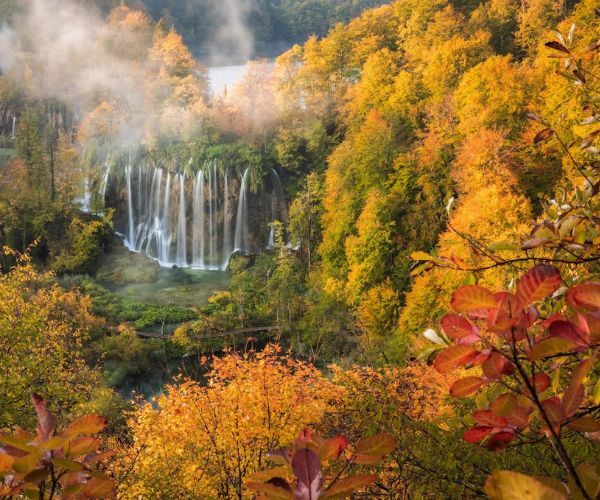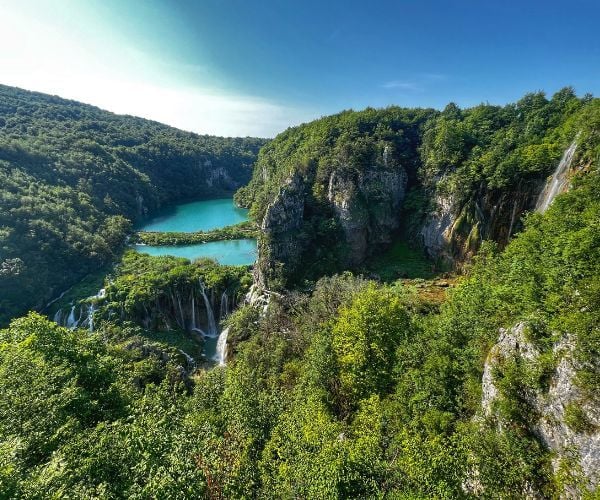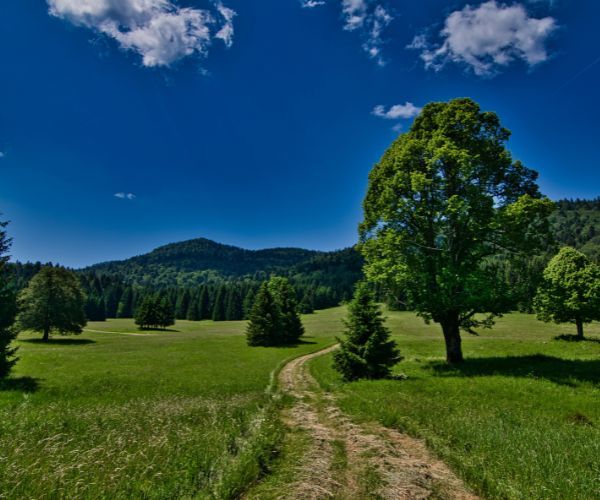A story of the forests of the Plitvice Lakes National Park
The Plitvice Lakes National Park is adorned by lush forests, each with its unique characteristics and ecological value. From the tall beech and fir trees to the mesmerising hop-hornbeams, these forests are more than just a green space – they are vital eco-systems nurturing a wealth of flora and fauna.

The forests of the National Park
The Plitvice Lakes National Park is nestled in a mountainous region in Croatia, on the southern portion of the Mala Kapela mountain range, between 369 and 1279 metres above sea level. The area is characterised by a temperate and humid climate with warm summers, creating ideal conditions for beech tree growth, which earned it the title of the “beech climate”. The forests surrounding the Plitvice Lakes are one of the most significant natural elements in this national park. They mostly consist of deciduous trees such as beech and hornbeam, as well as evergreen trees such as fir and spruce, and many other species. These forests are an important natural habitat for many animal species, including the brown bear, wolves, wild boar, bobcats, roe deer and red deer, as well as various bird and reptile species.

Observing the forest areas in the Plitvice Lakes National Park, we can make out two zones – the beech forest zone and the beech-fir forest zone, which are the permanent forms of vegetation. The combination of terrain, geological substrate, soil depth and humidity led to the creation of a diverse vegetation which includes willow, black alder, hop-hornbeam, Scots pine and spruce forests.
Visitors can explore the forest trails and paths, take in the gorgeous scenery and admire the crystal-clear lakes connected by waterfalls of various heights, as this area gives one a unique chance to connect with nature and explore its abundant flora and fauna.
Čorkova Uvala
The Čorkova Uvala rain forest is a unique jewel situated in the north-western portion of the Plitvice Lakes National Park. This amazing rainforest stretches over 84 hectares and is a genuine natural phenomenon. It is considered a secondary rainforest, meaning that it developed with only minor human impact, which created a pristine natural oasis.
As you stroll through this rainforest, you will be able to witness undisturbed life cycles. The Čorkova Uvala rainforest enables the development of all components of a rainforest ecosystem through all of its life-stages and one of them is sure to catch your eye: the abundance of trees of different heights, thickness and ages. The forest is home to Scots pines over 500 years old and up to 58 metres tall, with an impressive 150 cm diameter. The beech and spruce trees also achieved extraordinary sizes, creating a breathtaking view.

This rainforest is constantly going through changes taking place over centuries long periods. This includes changes in the ratio of tree species, vertical layering, density and number of snags, amount of dead wood, amount and size of openings in the tree tops, probability of trees being blown over or broken by the wind, and infestation of trees by harmful insects. However, these phenomena do not affect the entire rainforest at once, but rather occur in individual parts of the forest, resulting in a mosaic appearance.
Rainforests like Čorkova Uvala are extremely valuable for the preservation of natural heritage as they are home to highly varied flora and fauna and crucial for our understanding of the natural forest structure, as well as important reference points for assessing the efficiency of forest management.
If you wish to truly experience the power of nature and explore a beautiful and pristine rainforest, make sure to visit Čorkova Uvala – give in to its magical atmosphere and connect with nature in a truly unique way.
Hiking trails of the Plitvice Lakes National Park
The Plitvice Lakes National Park is renowned for its remarkable nature, consisting of a network of lakes, waterfalls and forests. The park offers 8 tour programmes which take visitors to the most famous lakes and waterfalls, as well as several hiking trails which enable visitors to explore this fascinating area in their own way.
One of the most popular hiking trails in the Plitvice Lakes National Park is the Medveđak trail, which enables visitors to immerse themselves in a forest adventure and explore some less known parts of the park. During their hike, visitors will encounter numerous viewpoints from which they can enjoy the spectacular views of the gorgeous nature of the park.

Another popular hiking trail in the Plitvice Lakes National Park is the Čorkova Uvala trail, taking visitors through a thick forest and over wooden bridges and giving them the chance to explore hidden corners of the park while soaking in the peace and quiet of the pristine nature.
The third trail that definitely bears mentioning is the Plitvica trail. This trail is somewhat shorter than the previous two, but it also offers a unique forest hiking experience through its more open parts. The trail also gives visitors the opportunity to see many plant and animal species, making it perfect for all nature lovers.
It is impossible to fully experience the Plitvice Lakes National Park without getting to know its forest eco-systems which cover over three quarters of its total area, so when you visit Plitvice Lakes, make sure to explore these hiking trails. Hiking over these trails, visitors have the chance to connect with nature, breathe in some fresh air and enjoy the fascinating scenery. Discover the mysterious world of this area and make memories to last a lifetime.
Abundance of species
Once you start exploring the highly bio-diverse environment of the Plitvice Lakes National Park, you get to immerse yourself in the wealth of its forested areas. The wilderness is home to a remarkable variety of tree species, which create a harmonious tapestry of colours, shapes and textures.
The park is dominated by beech forests and beech-fir forests, at altitudes ranging from 500 to 800 metres. Each of them has their own unique character and represents a harmonious coexistence of tree and plant species, from the beech trees and nettle, to the blue spruce and the black hellebore.
The importance of these forests goes beyond their role as a habitat. They are vital for the protection of soil from erosion, they affect the climate and hydrology, and contribute to oxygen production. These eco-systems play a crucial role in the preservation of the diversity of nature and wild animals.

The European beech is one of the most abundant trees in the park’s dense forests. Its smooth, silvery-grey bark and vividly green leaves, which turn a warm golden shade in autumn, give the scenery a dash of elegance. These trees often cover the hiking trails, creating some much-needed refreshing shade during summer. The fir is another easily recognisable species in the park, known for its tall and straight trunks and cone-shaped crown, and it provides a sense of grandeur to the forested areas.
The deciduous hornbeam trees are often found in these forests and their enchanting spectrum of red and orange shades in autumn gives some additional colour to the scenery. Apart from the dominating beech trees, these forests are also home to other species, such as maple and wild cherry.
The forest eco-systems of the park show all of the beauty and complexity of the nature. They serve as a reminder of the vital importance of preserving this natural wealth so as to enable future generations to admire and study them.
The crucial role of the forests
The forests of the Plitvice Lakes National Park play a crucial role in the park’s eco-system. They influence the hydrological conditions, slow down the surface drainage and increase water absorption in the soil, reducing the loss of water through vaporisation. Moreover, these forest giants contribute to oxygen production and carbon storage.

As you explore these mesmerising forests throughout the year, you can witness their unique beauty over the seasons, from vivid colours in spring to warm shades in autumn. These forests are not only a part of our park – they are its heart and soul, home to diverse flora and fauna, making this nature’s wonderland truly extraordinary.
Tomislav Kovačević is General Manager at Plitvice Lakes National Park. Plitvice Lakes National Park is the oldest and biggest national park in Croatia.
If you would like to be a guest blogger on A Luxury Travel Blog in order to raise your profile, please contact us.
Did you enjoy this article?
Receive similar content direct to your inbox.



Somehow I missed out on learning tree names at school and growing up. It was nice to learn what there is to see in the Plitvice forests.
Dear Dave, we are glad that you enjoyed our blog. We hope that you will visit us and see our forest in person. :) Regards from Plitvice Lakes National Park!
Forests are so calming and soothing. My dream holiday would be walking through these forests.
Dear Claire, thank you for the lovely comment. We are glad that you enjoyed our blog and the photos. We hope that you will visit us and that you will enjoy the walk through our beautiful forests. :) Regards from Plitvice Lakes National Park.
Is Plitvice Europe’s version of New England’s Fall? Now must be a great time to visit.
Dear Jack, fall in the Plitvice Lakes National Park is amazingly beautiful. We hope that you will visit us soon and discover all the wonderful colors. :) Regards from Plitvice Lakes National Park.
Two pictures here with amazing colours to remind us that autumn is blowing in.
Dear Grace, we are glad that you like our pictures. Yes, the colors are amazing and we hope that you will visit us and see them for yourself. :) Regards from Plitvice Lakes National Park!
Over the last few years I’ve found long haul flights hard work. It could be something to do with my ever increasing age.
More and more I’m looking at short-haul flights from the UK into Europe. I’m sure that there are plenty of places like Plitvice that would be as enjoyable as somewhere that’s 10 or 11 hours flying away.
Dear Kenny, we are looking forward to your visit. We are glad that you enjoyed reading our blog. :) Regards from Plitvice Lakes National Park!